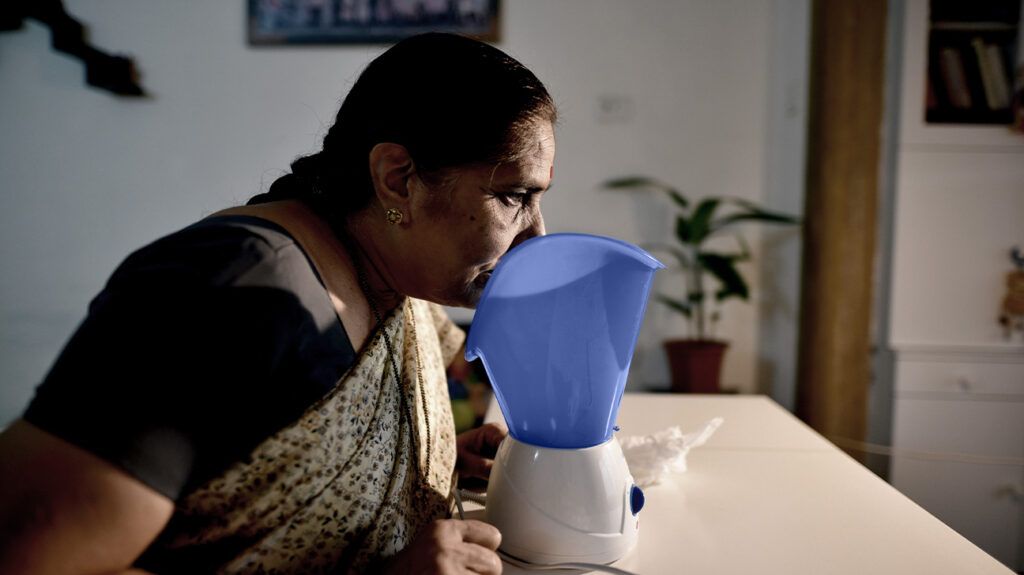Steam inhalations for bronchitis may help ease respiratory symptoms, such as coughing and congestion. However, they will not treat the underlying cause of the bronchitis.
Bronchitis is inflammation of the bronchial tubes, which are the airways that carry air to and from the lungs. Infections can cause acute bronchitis. Smoking or exposure to irritants can cause chronic bronchitis.
Steam inhalations are a popular home remedy for respiratory conditions. However, a
Keep reading to learn more about steam inhalations for bronchitis, including the ingredients that might help, whether nebulizers or inhalers help, and what else may ease symptoms.

Steam inhalations may benefit some people with bronchitis, particularly those experiencing congestion, mucus buildup, and coughing.
A doctor may recommend inhaling warm, moist air to soothe irritated airways and promote better mucus clearance, providing relief and comfort during recovery.
The theory behind using steam inhalations is that the warm steam may help moisturize the respiratory passages, which may assist in loosening thick mucus. This could make it easier to expel from the airways, improving chest discomfort.
However, this does not treat or cure the bronchitis itself. It can only help manage the symptoms.
Additionally, despite this home remedy being popular since the
A
There are conflicting opinions about the merits of steam inhalation alone, but some people add extra ingredients that may have additional benefits. These include:
- Eucalyptus essential oil: Eucalyptus oil has decongestant properties that can help clear nasal passages. According to a
2021 review of older research, it may help treat the symptoms of bronchiolitis, which is a type of lung infection. It may also have antiviral properties. - Peppermint oil: This essential oil is a traditional remedy for congestion and respiratory conditions.
- Tea tree oil: This oil has antimicrobial properties, but no studies have tested whether it can help cure acute bronchitis in humans.
The quality of the research on these oils varies significantly, so it is unclear how well they work for either form of bronchitis.
Some people may feel a benefit from inhaling these oils via steam. An alternative way to use them is to apply a drop onto a piece of cloth and inhale the scent. This removes the risk of scalds and burns.
With either method, people should use essential oils cautiously. Some essential oils are toxic and can be dangerous, especially in children, pets, and pregnant people.
For example, pregnant people should not use tea tree oil. The menthol in peppermint oil
Always talk with a doctor before using alternative remedies for a health condition.
Doctors
Inhalers are handheld devices that contain a pressurized canister of medication to release a specific dose of medication in aerosol form.
Nebulizers convert liquid medication into a fine mist for inhalation through a mask or mouthpiece.
These devices deliver medications directly to the bronchial tubes, offering targeted relief to manage bronchitis symptoms.
Inhalers and nebulizers can deliver different types of medications, such as:
Bronchodilators
These medications work by relaxing the muscles around the airways, which helps widen the bronchial tubes and makes breathing easier.
Short-acting beta-2 agonists, such as albuterol and salbutamol, can provide quick relief during symptom flare-ups.
Long-acting bronchodilators, such as arformoterol tartrate (Brovana) and formoterol fumarate (Oxeze, Foradil), can help with daily maintenance to manage chronic bronchitis.
Corticosteroids
Corticosteroids are anti-inflammatory medications that help reduce inflammation in the bronchial tubes. They may help control the inflammation of chronic bronchitis and prevent flare-ups.
There is no scientific evidence that steam inhalations reliably speed recovery from acute bronchitis.
When someone becomes ill with acute bronchitis, their immune system initiates a series of complex defense mechanisms to fight the infection.
While the immune system works to clear the viral infection, this process requires time. The duration of the immune response varies between people. Therefore, people typically need a few weeks to recover from acute bronchitis, whether using inhalations or not.
Inhalations can relieve bronchitis symptoms and help manage the condition so a person is more comfortable.
Usually, acute bronchitis goes away after several weeks. During that time, people can ease symptoms by:
- resting
- drinking plenty of fluids
- using over-the-counter (OTC) cough medications
- taking OTC pain medications
Antibiotics will not help with viral infections. However, if a doctor suspects the bronchitis could be due to a bacterial infection, they may prescribe one.
Bronchitis is not deadly for most people, but it may depend on the type of bronchitis.
Acute bronchitis is
Rarely, people with acute bronchitis develop acute respiratory distress syndrome and respiratory failure, but this is very uncommon.
Chronic bronchitis is a type of chronic obstructive pulmonary disease (COPD). It
The outlook for a person with chronic bronchitis depends on several factors, including:
- the person’s overall health
- whether they smoke
- the severity of the condition
- the person’s adherence to medical advice and treatments
If left unmanaged, chronic bronchitis can lead to complications such as:
- respiratory infections
- respiratory failure
- reduced quality of life
For some people, steam inhalations may help ease bronchitis symptoms, such as congestion, coughing, and chest discomfort. However, steam inhalations do not directly treat the cause of the bronchitis. There is a lack of evidence that this works.
Bronchitis can be acute or chronic. Acute bronchitis can result from an infection. Chronic bronchitis is a long-term condition that occurs due to smoking or irritant exposure.
Most cases of acute bronchitis get better on their own. Chronic bronchitis can lead to complications without treatment.
Steam inhalations may help people cope with these conditions, but if a person is experiencing ongoing or recurring symptoms, they should speak with a doctor.
